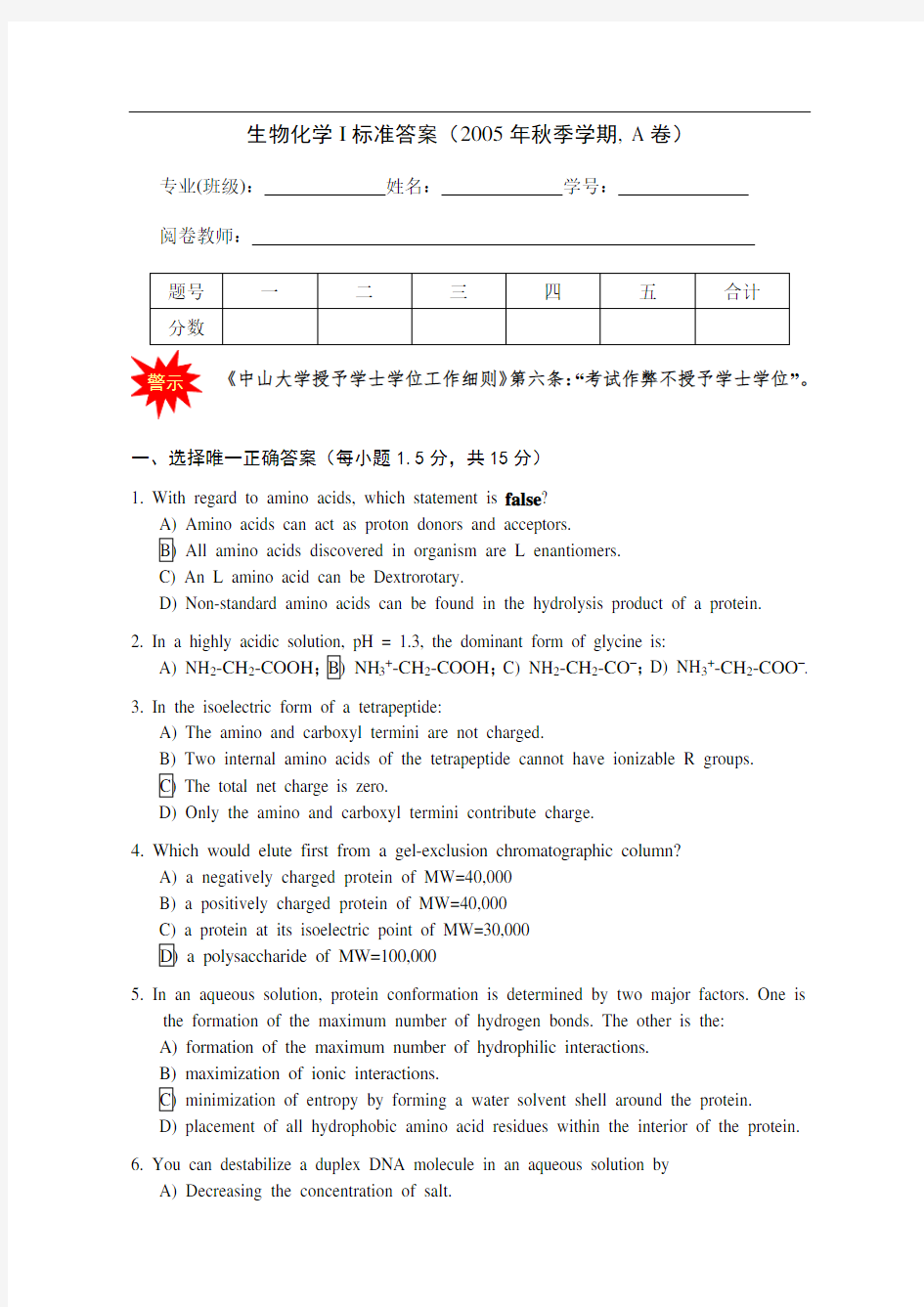中大生物化学试题答案与评分标准(秋季,A卷)


生物化学I 标准答案(2005年秋季学期, A 卷)
专业(班级): 姓名: 学号: 阅卷教师:
《中山大学授予学士学位工作细则》第六条:“考试作弊不授予学士学位”
。
一、选择唯一正确答案(每小题1.5分,共15分)
1. With regard to amino acids, which statement is false ?
C) An L amino acid can be Dextrorotary.
D) Non-standard amino acids can be found in the hydrolysis product of a protein. 2. In a highly acidic solution, pH = 1.3, the dominant form of glycine is: A) NH 2-CH 2-COOH 3+-CH 2-COOH ;C) NH
2-CH 2-CO –;D) NH
3+-CH 2-COO –. 3. In the isoelectric form of a tetrapeptide:
A) The amino and carboxyl termini are not charged.
B) Two internal amino acids of the tetrapeptide cannot have ionizable R groups. D) Only the amino and carboxyl termini contribute charge. 4. Which would elute first from a gel-exclusion chromatographic column? A) a negatively charged protein of MW=40,000 B) a positively charged protein of MW=40,000 C) a protein at its isoelectric point of MW=30,000 5. In an aqueous solution, protein conformation is determined by two major factors. One is
the formation of the maximum number of hydrogen bonds. The other is the: A) formation of the maximum number of hydrophilic interactions. B) maximization of ionic interactions.
D) placement of all hydrophobic amino acid residues within the interior of the protein. 6. You can destabilize a duplex DNA molecule in an aqueous solution by A) Decreasing the concentration of salt.
B) Decreasing the concentration of organic solvents.
C) Adjusting the pH to a value near 7.
D) Adding a detergent.
7. With regard to DNA, which statement is false?
A) Triple helix and tetraplex tend to appear at sites where replication, recombination or
transcription is initiated or regulated.
B) Hydrogen bonds are the only force to stabilize DNA structure.
C) The absorbance of DNA at 260 nm will rise when it is denatured.
D) Z-DNA tracts may play an role in the regulation of the expression of some genes or
in genetic recombination.
8. Thr and/or Leu residues tend to disrupt an helix when they occur next to each other in
a protein because:
A) of electrostatic repulsion between the Thr and/or Leu side chains.
B) both amino acids are highly hydrophobic.
C) the R group of neither amino acid can form a hydrogen bond.
D) of steric hindrance between the bulky Thr and/or Leu side chains.
9. To calculate the turnover number of an enzyme you need to know the:
A) initial velocity of the catalyzed reaction at [S] >> Km.
B) Km for the substrate.
C) enzyme concentration.
D) both A and C.
10. In glycoproteins, the carbohydrate moiety is always attached through the amino acid
residues:
A) tryptophan, aspartate, or cysteine; B) asparagine, serine, or threonine.
C) glycine, alanine, or aspartate; D) aspartate or glutamate.
二、看图填空(每小题5分,共25分)
1. Consider this figure which shows oxygen binding to
myoglobin or hemoglobin. For (1-7) indicate which
(one or more) curve(s) fit the description (5points).
(1) A, B Show(s) cooperative oxygen binding;
(2) A, B Can be compared to the Bohr effect;
(3) C Has the smallest P50;
(4) C Correspond(s) to oxygen binding by
isolated beta chains of Hb;
(5) A, B, C Show(s) reversible oxygen binding;
(6) A Correspond(s) to Hb with large amounts of BPG bound;
(7) A Corresponds to an increase in CO2
2. The following figure shows the model of peptides. The letters of A, B, C, D, E and F
represent the atoms or side group of amino acids. The letters of G and H stand for the bond angle ψ or φ. Fill the blanks according to the figure (5points).
(1) A = side group, B = alpha carbon atom, D = oxygen atom,
E = nitrogen atom,
F = hydrogen atom;
(2) The conformation of the peptide is defined by the values of ψ( H ) and φ ( G );
(3) T he peptide bond between C and E has partial double-bond character;
(4) The atoms ( D, C, E, F ) form the peptide plane;
(5) If the peptide is an alpha helix, indicate the H bond on the figure (NON).
3. Supersecondary structure of proteins (5 points).
(1) β-α-β Loop A ;
(2) Greek Key E ;
(3) α-α Corner D ;
(4) Right-handed connection between β strands C ;
(5) Not observed B ;
(6) Very rare F .
4. Protein classification (5 points).
(1) All α A ; (2) All β D ; (3) α/β E ;
(4) α+β F ; (5) Superfamily B ; (6) Species C
5. Biomembrane lipids (5 points)
(1) Sphingolipids A ; (2) Phospholipase A1 C
(3) Phospholipase A2 D ; (4) Phospholipase C E
(5) Sphingosine B
三、关于酶的组题(答题要简洁,条理清晰,有针对性。如果你要回答的内容在前
面已经给出,可以采用“参见……”的引用方式,以便节省答题时间)
1.酶为什么具有催化功能?(4分)
答:酶可以降低反应的活化能,使反应速度加快【2分】,降低活化能的因素有:(1)酶与底物的相互诱导结合产生结合能【1分】,包括反应物的商减少效应、脱溶
剂效应、电子云的定向重排效应、酶对过渡态的稳定效应;(2)活性中心特殊基团的催化作用【1分】,包括酸碱催化、共键催化、金属离子催化等。
2.为什么糜蛋白酶(Chymotrypsin)属于丝氨酸蛋白水解酶家族?你还知道那些丝氨酸蛋白水解酶以及蛋白水解酶家族?(4分)
答:糜蛋白酶活性中心的Ser残基在蛋白质水解反应中起重要的催化作用【1】——酸碱催化和共价催化【1】。
其它丝氨酸蛋白酶如:trypsin (胰蛋白酶),elastase (弹性蛋白酶),subtilisin (枯草杆菌蛋白酶,thrombin(凝血酶),plasmin(血纤维蛋白溶酶)等【中英文皆可,写出两个以上给1分,写出1个给0.5分】。
其它蛋白水解酶家族:天冬氨酸(Asp)蛋白水解酶家族,光氨酸(Cys)蛋白水解酶家族,金属蛋白水解酶家族等【中英文皆可,写出两个以上给1分,写出1个给0.5分】。
3.酶为什么具有最适催化温度和pH值?(4分)
答:最适温度:温度的升高可以使任何化
学反应的速度加快【1分】;过高的
温度会使酶的构象变化,使酶的催化
能力降低【1分】,矛盾双方的调和
使酶有一个最佳的催化温度。
最适pH值:酶的酸碱或共价催化需
要催化基团处于质子化或脱质子化状
态【1分】,对pH有依赖性;同时
pH的变化对稳定酶构象的相互作用,
特别是静电相互作用有较大影响【1
分】。上述因素的综合,会使酶有一
个最佳的催化pH值。
4.糜蛋白酶的催化动力学曲线与肌红蛋
白的氧合曲线类似;天冬氨酸转氨甲酰
酶(ATCase)是一个变构酶,它的催
化动力学曲线是否与血红蛋白的氧合曲线类似,为什么?(4分)
答:类似【2分】。理由:ATCase和血红蛋白都属于寡聚体变构(别构)蛋白,它们包含多个与底物/效应物结合位点【1分】;某一结合位点与底物/效应物的结合通过构象变化会影响(加强或减弱)到其它位点与底物/效应物的结合(变构效应)【1分】。它们的催化或结合动力学不遵从Michaelis-Menten方程(双曲线),一般为S形曲线。
5.糜蛋白酶的一级结构及其激活过程如图所示,这个激活顺序能否颠倒?给出理由(4分)
答:不能颠倒【2分】。理由:可能糜蛋白酶原上只暴露有胰蛋白酶的切割位点(水解),而糜蛋白酶的切割位点尚未暴露【1分】;当胰蛋白酶对糜蛋白酶原进行切割后,结构会发生调整变化,才暴露出糜蛋白酶(π-Chymotrypsin, α-Chymotrypsin)的切割位点【1分】。
6.对于人工酶(如环糊精)、核酶(RNA)、抗体酶、同工酶、以及具有催化功能的脂类分子集合体等具有明显区别的概念或对象,你能用什么基本原理将他们统一在“催化”的旗帜下?给出理由(4分)
答:用酶的催化机理来统一【2分】。理由:这些对象虽然属于不同物质类别或分子整体结构大不相同,但他们一定有能与他们各自的底物相结合的活性中心,通过各种效应(参见答1)来完成催化功能【2分】,因此,酶不一定是蛋白质,只要是能提供执行催化机理的有序基团集合(即活性中心)的物质(分子)结构,就具有酶的功能。
四、关于膜的组题(答题要简洁,条理清晰,有针对性。如果你要回答的内容在前
面已经给出,可以采用“参见……”的引用方式,以便节省答题时间)
1.生物膜有哪些功能?(3分)
答:(1) 形成边界,使细胞与环境隔离【1分】;(2) 使细胞的内部结构分化,形成不同的功能分区【1分】;(3) 执行物质跨膜运输;(4) 执行对环境的信号转导;
(5) 细胞和细胞的直接通讯【后三点答出两点以上给1分,答出一点给0.5分】。2.膜蛋白有哪些存在方式?(3分)
答:膜蛋白包括整合(跨膜)膜蛋白和外周膜蛋白【0.5分】。跨膜蛋白包括span α-helix 和β-barrel两种形式【各0.5分】;外周蛋白与膜结合的方式有lipid linked,lipid bound,span-protein bound【各0.5分】。
3.列举细胞膜的物质运输方式并分类(5分)
答:
【每项0.5分】
4.离子通道和泵的区别是什么?它们的工作是如何相关的?举例说明(5分)
答:区别:通道为被动运输,泵为主动运输【1分】;通道没有饱和性,泵有类似于酶与底物结合的饱和性【1分】。
工作相关:通道使跨膜离子梯度倾向于消失,而泵的作用使是建立跨膜离子梯度【1分】。例如,细胞膜内K离子浓度大大高于膜外,而Na离子浓度正好与此相反,K 离子通道和Na离子通道的开关产生静息电位和动作电位,使K离子和Na离子浓度梯度趋于消失,而Na-K泵则逆着浓度梯度使K离子运入膜内,Na离子运出膜外,维持膜两侧的K离子和Na离子浓度梯度【酌情给1~2分】
